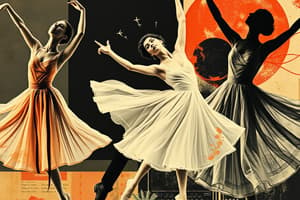Podcast
Questions and Answers
क्लासिकल संगीत किस शताब्दी में उभरा?
क्लासिकल संगीत किस शताब्दी में उभरा?
- २०वीं शताब्दी
- २१वीं शताब्दी
- १८वीं शताब्दी (correct)
- १९वीं शताब्दी
बैले फोल्कलोरिक नृत्य की उत्पत्ति कहाँ हुई?
बैले फोल्कलोरिक नृत्य की उत्पत्ति कहाँ हुई?
- इटली
- मेक्सिको (correct)
- भारत
- स्पेन
रेनेसां पेंटिंग की मुख्य विशेषताएं क्या हैं?
रेनेसां पेंटिंग की मुख्य विशेषताएं क्या हैं?
- ज्यामितीय टुकड़े और बहुल प्रस्पेक्टिव
- प्रकाश और रंग की महत्ता
- रियलिज्म और क्लासिकल प्रभाव (correct)
- अंधेरे और डरावने दृश्य
हिप-हॉप नृत्य की उत्पत्ति कब हुई?
हिप-हॉप नृत्य की उत्पत्ति कब हुई?
सांस्कृतिक हाइब्रिडिटी क्या है?
सांस्कृतिक हाइब्रिडिटी क्या है?
क्यूबिज्म कาลा में क्या प्रभाव हैं?
क्यूबिज्म कาลा में क्या प्रभाव हैं?
जैज संगीत किस शताब्दी में उभरा?
जैज संगीत किस शताब्दी में उभरा?
नेशनल आइडेंटिटी क्या है?
नेशनल आइडेंटिटी क्या है?
Flashcards are hidden until you start studying
Study Notes
Dance Styles
- Ballet: originated in Italy in the 15th century, characterized by graceful, flowing movements and often tells a story
- Jazz: emerged in the early 20th century, influenced by African American music and dance, emphasizing energy and spontaneity
- Hip-Hop: originated in the 1970s in New York City, characterized by breaking, popping, and locking, often incorporating rap music
- Ballet Folklorico: traditional Mexican dance, combining indigenous and European influences, featuring vibrant costumes and energetic footwork
- Kathak: classical dance form from India, characterized by intricate footwork, rapid turns, and storytelling through hand gestures
Music Genres
- Classical: originated in the 18th century, characterized by complex harmonies and orchestral instruments
- Jazz: emerged in the early 20th century, blending African American music traditions with European instrumentation
- Blues: originated in the Deep South in the late 19th century, characterized by soulful melodies and storytelling lyrics
- Rock: emerged in the 1950s, characterized by strong backbeat, electric instruments, and often rebellious lyrics
- Electronic: originated in the 20th century, featuring electronic instruments, synthesizers, and digital production techniques
History of Art
- Renaissance Art (14th-17th centuries): characterized by realism, humanism, and classical influences, featuring artists like Leonardo da Vinci and Michelangelo
- Baroque Art (17th century): marked by dramatic lighting, intense emotions, and ornate decoration, featuring artists like Caravaggio and Rembrandt
- Impressionism (late 19th century): emphasized capturing light and color, featuring artists like Claude Monet and Pierre-Auguste Renoir
- Cubism (early 20th century): characterized by geometric fragmentation and multiple perspectives, featuring artists like Pablo Picasso and Georges Braque
- Abstract Expressionism (mid-20th century): emphasized emotional expression and gestural brushstrokes, featuring artists like Jackson Pollock and Willem de Kooning
Cultural Identity
- National Identity: shaped by a nation's history, language, and customs
- Ethnic Identity: influenced by an individual's racial, linguistic, or religious heritage
- Gender Identity: shaped by societal expectations, personal experiences, and individual expression
- Cultural Hybridity: the blending of different cultural traditions, resulting in unique and diverse identities
- Globalization and Cultural Exchange: the exchange of ideas, values, and practices between cultures, leading to increased diversity and understanding
नृत्य शैलियाँ
- बैले: 15वीं शताब्दी में इटली में उत्पन्न, सुन्दर, प्रवाहमय आंदोलनों और कहानी सुनाने वाला है
- जैज: 20वीं शताब्दी के प्रारम्भ में उत्पन्न, अफ्रीकी अमेरिकी संगीत और नृत्य से प्रभावित, ऊर्जा और स्पонтानियता पर जोर देता है
- हिप-हॉप: न्यू यॉर्क शहर में 1970 के दशक में उत्पन्न, ब्रेकिंग, पॉपिंग और लॉकिंग की विशेषता और रैप संगीत का उपयोग करता है
- बैले फॉल्कलोरिको: पारंपरिक मेक्सिकन नृत्य, स्वदेशी और यूरोपीय प्रभावों का संयोजन, रंगीन पोशाकें और ऊर्जावान पादचार की विशेषता है
- कथक: भारतीय शास्त्रीय नृत्य शैली, पादचार, तेज धूर्त और हाथ से कथा सुनाने की विशेषता है
संगीत प्रकार
- क्लासिकल: 18वीं शताब्दी में उत्पन्न, जटिल स्वर और वाद्ययंत्रों की विशेषता है
- जैज: 20वीं शताब्दी के प्रारम्भ में उत्पन्न, अफ्रीकी अमेरिकी संगीत परम्पराओं और यूरोपीय वाद्ययंत्रों का संयोजन है
- ब्लूज: 19वीं शताब्दी के अंत में डीप साउथ में उत्पन्न, आत्मा से भरे सुर और कथा सुनाने वाले बोल की विशेषता है
- रॉक: 1950 के दशक में उत्पन्न, प्रबल पृष्ठभूमि स्वर, विद्युत् वाद्ययंत्र और अक्सर विद्रोही बोल की विशेषता है
- इलेक्ट्रॉनिक: 20वीं शताब्दी में उत्पन्न, विद्युत् वाद्ययंत्र, सिंथेसाइज़र और डिजिटल उत्पादन तकनीक की विशेषता है
कला इतिहास
- रेनेसانس कला (14वीं-17वीं शताब्दी): यथार्थवाद, मानववाद और शास्त्रीय प्रभावों की विशेषता है, लियोनार्डो दा विंची और माइकल एंजेलो जैसे कलाकारों की विशेषता है
- बारोक कला (17वीं शताब्दी): ड्रामेटिक प्रकाश, तीव्र भाव और सजावट की विशेषता है, कारवाज्जियो और रेम्ब्रेंट जैसे कलाकारों की विशेषता है
- इंप्रेशَنिज़्म (Late 19वीं शताब्दी): प्रकाश और रंग से युक्त, क्लॉड मोनेट और पियरे-ऑगस्टे ре诺यर जैसे कलाकारों की विशेषता है
- क्यूबिज़्म (Early 20वीं शताब्दी): ज्यामितीय टुकड़ियों और बहु-दृष्टि की विशेषता है, पाब्लो पिकासो और जॉर्ज ब्रैक जैसे कलाकारों की विशेषता है
- एब्स्ट्रैक्ट एक्सप्रेश़निज़्म (Mid 20वीं शताब्दी): भावात्मक अभिव्यक्ति और हस्तचालित झाड़ियों की विशेषता है, जैक्सन पोलॉक और विल्लेम दे कूनिंग जैसे कलाकारों की विशेषता है
सांस्कृतिक पहचान
- राष्ट्रीय पहचान: एक राष्ट्र के इतिहास, भाषा और रीति-रिवाज से आकार लेती है
- नस्लीय पहचान: एक व्यक्ति की नस्ल, भाषा या धार्मिक विरासत से प्रभावित होती है
- लिंग पहचान: सामाजिक उम्मीदों, व्यक्तिगत अनुभवों और व्यक्तिगत अभिव्यक्ति से आकार लेती है
- सांस्कृतिक संकरता: विभिन्न सांस्कृतिक परम्पराओं का मिश्रण, अद्वितीय और विविध पहचान पैदा करता है
- वैश्वीकरण और सांस्कृतिक विनिमय: विभिन्न संस्कृतियों के बीच विचारों, मूल्यों और प्रथाओं का आदान-प्रदान, विविधता और समझ को बढ़ाता है
Studying That Suits You
Use AI to generate personalized quizzes and flashcards to suit your learning preferences.




